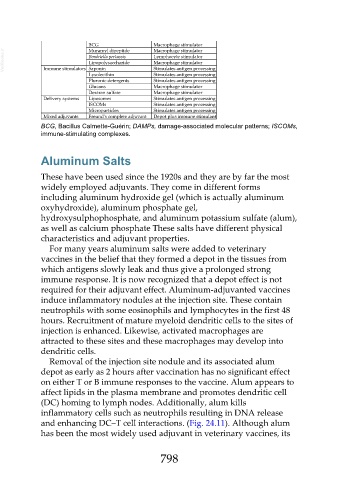Page 798 - Veterinary Immunology, 10th Edition
P. 798
BCG Macrophage stimulator
VetBooks.ir Bordetella pertussis Lymphocyte stimulator
Muramyl dipeptide
Macrophage stimulator
Lipopolysaccharide
Macrophage stimulator
Immune stimulators Saponin
Stimulates antigen processing
Lysolecithin Stimulates antigen processing
Pluronic detergents Stimulates antigen processing
Glucans Macrophage stimulator
Dextran sulfate Macrophage stimulator
Delivery systems Liposomes Stimulates antigen processing
ISCOMs Stimulates antigen processing
Microparticles Stimulates antigen processing
Mixed adjuvants Freund's complete adjuvant Depot plus immune stimulant
BCG, Bacillus Calmette-Guérin; DAMPs, damage-associated molecular patterns; ISCOMs,
immune-stimulating complexes.
Aluminum Salts
These have been used since the 1920s and they are by far the most
widely employed adjuvants. They come in different forms
including aluminum hydroxide gel (which is actually aluminum
oxyhydroxide), aluminum phosphate gel,
hydroxysulphophosphate, and aluminum potassium sulfate (alum),
as well as calcium phosphate These salts have different physical
characteristics and adjuvant properties.
For many years aluminum salts were added to veterinary
vaccines in the belief that they formed a depot in the tissues from
which antigens slowly leak and thus give a prolonged strong
immune response. It is now recognized that a depot effect is not
required for their adjuvant effect. Aluminum-adjuvanted vaccines
induce inflammatory nodules at the injection site. These contain
neutrophils with some eosinophils and lymphocytes in the first 48
hours. Recruitment of mature myeloid dendritic cells to the sites of
injection is enhanced. Likewise, activated macrophages are
attracted to these sites and these macrophages may develop into
dendritic cells.
Removal of the injection site nodule and its associated alum
depot as early as 2 hours after vaccination has no significant effect
on either T or B immune responses to the vaccine. Alum appears to
affect lipids in the plasma membrane and promotes dendritic cell
(DC) homing to lymph nodes. Additionally, alum kills
inflammatory cells such as neutrophils resulting in DNA release
and enhancing DC–T cell interactions. (Fig. 24.11). Although alum
has been the most widely used adjuvant in veterinary vaccines, its
798

